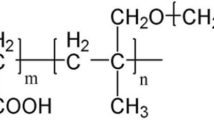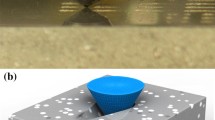Abstract
Investigating the mechanism of multi-walled carbon nanotube (MWCNT) in the early cement hydration enables better utilization of the potential of MWCNT as reinforcing agents in cement composites. The interaction of MWCNT with ions and its effect on cement hydration were investigated. Zeta potential measurement was intended to discuss the interaction of the MWCNT surface with Ca2+. Then, the formation processes of C–S–H were observed with a scanning electron microscope (SEM). The influence of MWCNT on the early cement hydration was investigated using isothermal calorimetry. The results showed that MWCNT significantly accelerates early cement hydration. It is likely attributed to its high surface area and strong adsorption for Ca2+, which greatly promotes the migration of ions, especially Ca2+, and thus the precipitation of ions on the cement surface. This facilitates the C–S–H nucleation and growth process, thus the cement hydration. These results also indicated that the MWCNT would not provide a stable nucleation site for C–S–H, since the size of MWCNT is less than that of C–S–H.







Similar content being viewed by others
References
Dong W, Li W, Luo Z, Guo Y, Wang K (2020) Effect of layer-distributed carbon nanotube (CNT) on mechanical and piezoresistive performance of intelligent cement-based sensor. Nanotechnol 31(50):505503–505516
Dong W, Li W, Shen L, Sun Z, Sheng D (2020) Piezoresistivity of smart carbon nanotubes (CNTs) reinforced cementitious composite under integrated cyclic compression and impact. Compos Struct 241:112106–112138
Dong W, Li W, Tao Z, Wang K (2019) Piezoresistive properties of cement-based sensors: review and perspective. Constr Build Mater 203:146–163
Dong W, Li W, Wang K, Shah SP (2021) Physicochemical and piezoresistive properties of smart cementitious composites with graphene nanoplates and graphite plates. Constr Build Mater 286:122943–122955
El-Gamal SMS, El-Hosiny FI, Amin MS, Sayed DG (2017) Ceramic waste as an efficient material for enhancing the fire resistance and mechanical properties of hardened Portland cement pastes. Constr Build Mater 154:1062–1078
Garrault-Gauffinet S, Nonat A (1999) Experimental investigation of calcium silicate hydrate (C-S-H) nucleation. J Cryst Growth 200(3/4):565–574
Goldberg S (1992) Chemistry of the solid-water interface: processes at the mineral-water and particle-water interface in natural systems. Geochim Cosmochim Acta 57(3):205–219
Han B, Yang Z, Shi X, Yu X (2012) Transport properties of carbon-nanotube/cement composites. J Mater Eng Perform 22(1):184–189
Hawreen A, Bogas JA (2018) Influence of carbon nanotubes on steel–concrete bond strength. Mater Struct 51(6):1–10
Iqbal S, Ali I, Room S, Khan SA, Ali A (2019) Enhanced mechanical properties of fiber reinforced concrete using closed steel fibers. Mater Struct 52(3):1–10
Jang D, Yoon HN, Farooq SZ, Lee HK, Nam IW (2021) Influence of water ingress on the electrical properties and electromechanical sensing capabilities of CNT/cement composites. J Build Eng 42:103065–103075
Konsta-Gdoutos MS, Metaxa ZS, Shah SP (2010) Multi-scale mechanical and fracture characteristics and early-age strain capacity of high performance carbon nanotube/cement nanocomposites. Cem Conc Compos 32(2):110–115
Krautwurst N, Nicoleau L, Dietzsch M, Lieberwirth I (2018) Two-step nucleation process of calcium silicate hydrate, the nano-brick of cement. Chem Mater 30:2895–2904
Leonavičius D, Pundienė I, Girskas G, Pranckevičienė J, Kligys M, Kairytė MA (2018) The effect of multi-walled carbon nanotubes on the rheological properties and hydration process of cement pastes. Constr Build Mater 189:947–954
Li F, Liu L, Yang Z, Li S (2021) Influence of modified multi-walled carbon nanotubes on the mechanical behavior and toughening mechanism of an environmentally friendly granulated blast furnace slag-based geopolymer matrix. Ceram Int 47(1):907–922
Makar JM, Chan GM (2009) Growth of cement hydration products on single-walled carbon nanotubes. J Am Ceram Soc 92(6):1303–1310
Mansouri Sarvandani M, Mahdikhani M, Aghabarati H, Haghparast Fatmehsari M (2021) Effect of functionalized multi-walled carbon nanotubes on mechanical properties and durability of cement mortars. J Build Eng 41:102407–102416
Mendoza Reales OA, Dias Toledo Filho R (2017) A review on the chemical, mechanical and microstructural characterization of carbon nanotubes-cement based composites. Constr Build Mater 154:697–710
Meng S, Ouyang X, Fu J, Niu Y, Ma Y (2021) The role of graphene/graphene oxide in cement hydration. Nanotechnol Rev 10(1):768–778
Moulin F, Devel M, Picaud S (2005) Molecular dynamics simulations of polarizable nanotubes interacting with water. Phys Rev B 71(16):1–7
Nachbaur PCNL, Nonat S, Mutin JC (1998) Electrokinetic properties which control the coagulation of silicate cement suspensions during early age hydration. J Coll Interface Sci 202(2):261–268
Nalon GH, Lopes Ribeiro JC, Pedroti LG, Duarte de Araújo EN, Franco de Carvalho JM, Soares de Lima GE, De Moura GL (2021) Residual piezoresistive properties of mortars containing carbon nanomaterials exposed to high temperatures. Cem Concr Compos 121:104104–104127
Nonat A (2004) The structure and stoichiometry of C-S-H. Cem Concr Res 34(9):1521–1528
Ouyang X, Koleva DA, Ye G, Van Breugel K (2017) Insights into the mechanisms of nucleation and growth of C-S–H on fillers. Mater Struct 50(5):1–13
Ouyang X, Koleva DA, Ye G, Van Breugel K (2017) Understanding the adhesion mechanisms between C S H and fillers. Cem Concre Res 100:275–283
Ouyang X, Wang L, Fu J, Xu S, Ma Y (2021) Surface properties of clay brick powder and its influence on hydration and strength development of cement paste. Constr Build Mater 300:123958–123967
Ouyang X, Wang L, Xu S, Ma Y, Ye G (2020) Surface characterization of carbonated recycled concrete fines and its effect on the rheology, hydration and strength development of cement paste. Cem Concr Compos 114:1–10
Paillet M, Poncharal P, Zahab A (2005) Electrostatics of individual single-walled carbon nanotubes investigated by electrostatic force microscopy. Phys Rev Lett 94(18):186801–186805
Pellenq RJM, Van Damme H (2011) Why does concrete set?: The nature of cohesion forces in hardened cement-based materials. MRS Bull 29(5):319–323
Petersson PE (1981) Crack growth and development of fracture zones in plain concrete and similar materials. Report TVBM 1006:1–193
Petrunin S, Vaganov V, Reshetniak V, Zakrevskaya L (2015) Influence of carbon nanotubes on the structure formation of cement matrix. IOP Conf Series: Mater Sci Eng 96:1–6
Poppe AM, De Schutter G (2005) Cement hydration in the presence of high filler contents. Cem Concre Res 35(12):2290–2299
Qin R, Zhou A, Yu Z, Wang Q, Lau D (2021) Role of carbon nanotube in reinforcing cementitious materials: an experimental and coarse-grained molecular dynamics study. Cem Concre Res 147:106517–106529
Ren Z, Liu Y, Yuan L, Luan C, Wang J, Cheng X, Zhou Z (2021) Optimizing the content of nano-SiO2, nano-TiO2 and nano-CaCO3 in Portland cement paste by response surface methodology. J Build Eng 35:102073–102085
Shi T, Gao Y, Corr DJ, Shah SP (2019) FTIR study on early-age hydration of carbon nanotubes-modified cement-based materials. Adv Cem Res 31(8):353–361
Siddique R, Mehta A (2014) Effect of carbon nanotubes on properties of cement mortars. Constr Build Mater 50:116–129
De Souza TC, Pinto G, Cruz VS, Moura M, Ladeira LO, Calixto JM (2020) Evaluation of the rheological behavior, hydration process, and mechanical strength of Portland cement pastes produced with carbon nanotubes synthesized directly on clinker. Constr Build Mater 248:118686–118699
Tafesse M, Kim HK (2019) The role of carbon nanotube on hydration kinetics and shrinkage of cement composite. Compos Part B: Eng 169:55–64
Tafesse M, Lee NK, Alemu AS, Lee HK, Kim SW, Kim HK (2021) Flowability and electrical properties of cement composites with mechanical dispersion of carbon nanotube. Constr Build Mater 293:123436–123454
Vekilov PG (2010) Nucleation. Cryst Growth Des 10(12):5007–5019
Viallis-Terrisse H, Nonat A, Petit JC (2001) Zeta-potential study of calcium silicate hydrates interacting with alkaline cations. J Colloid Interface Sci 244(1):58–65
Wang J, Han B, Li Z, Yu X, Dong X (2019) Effect investigation of nanofillers on C-S-H gel structure with Si NMR. J Mater Civil Eng 31(1):04018352–04018364
Xu S, Lyu Y, Xu S, Li Q (2019) Enhancing the initial cracking fracture toughness of steel-polyvinyl alcohol hybrid fibers ultra high toughness cementitious composites by incorporating multi-walled carbon nanotubes. Constr Build Mater 195:269–282
Zhao L, Guo X, Song L, Song Y, Dai G, Liu J (2020) An intensive review on the role of graphene oxide in cement-based materials. Constr Build Mater 241:117939–117956
Funding
The authors would like to acknowledge the financial support from the National Nature Science Foundation of China (Grant No. 52008119), the Natural Science Foundation of Guangdong Province (Grant No. 2019A1515110799 and 2021A1515012624), and the 111 Project (Grant No. D21021) and the Guangzhou Municipal Science and Technology Project (Grant No. 20212200004).
Author information
Authors and Affiliations
Corresponding author
Ethics declarations
Conflict of interest
The authors declare that they have no known competing financial interests or personal relationships that could have appeared to influence the work reported in this paper.
Additional information
Publisher's Note
Springer Nature remains neutral with regard to jurisdictional claims in published maps and institutional affiliations.
Rights and permissions
About this article
Cite this article
Meng, S., Ouyang, X., Fu, J. et al. New insights into the role of MWCNT in cement hydration. Mater Struct 54, 238 (2021). https://doi.org/10.1617/s11527-021-01832-5
Received:
Accepted:
Published:
DOI: https://doi.org/10.1617/s11527-021-01832-5




